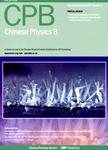Preparation and magnetic hardening of low Ti content (Sm,Zr)(Fe,Co,Ti)12 magnets by rapid solidification non-equilibrium method
作者机构:Beijing Univ Technol Coll Mat Sci & Engn Key Lab Adv Funct Mat Minist Educ China Beijing 100124 Peoples R China
出 版 物:《CHINESE PHYSICS B》 (中国物理B(英文版))
年 卷 期:2024年第33卷第9期
页 面:576-580页
核心收录:
学科分类:08[工学] 080502[工学-材料学] 0805[工学-材料科学与工程(可授工学、理学学位)]
基 金:National Key Research and Development Program of China [2021YFB3500300] National Natural Science Foundation of China Program of Top Disciplines Construction in Beijing [PXM2019_014204_500031]
主 题:magnetic materials (Sm,Zr)(Fe,Co,Ti)(12) magnets nanocrystalline magnet microstructure 75.50.Ww 75.75.-C 75.75.Cd THMN12 STRUCTURE ALLOYS MICROSTRUCTURE NANOCOMPOSITES NANOSTRUCTURES EVOLUTION SM
摘 要:The Sm-Zr-Fe-Co-Ti quinary-alloys with ThMn12 structure has attracted wide attention for ultra-high intrinsic magnetic properties, showing potentiality to be developed into rare-earth permanent magnets. The Ti element in alloys is crucial for phase stability and magnetic properties, and lower Ti content can increase intrinsic magnetic properties but reduce phase stability. In this study, the 1:12 single-phase melt-spun ribbons with low Ti content was successfully prepared using a rapid solidification non-equilibrium method for the Sm1.1Zr0.2Fe9.2Co2.3Ti0.5 quinary-alloy. However, this non-equilibrium ribbon did not achieve good magnetic hardening due to the uneven microstructure and microstrain. Then, annealing was carried out to eliminate micro-strain and homogenize microstructure, therefore, remanence and coercivity were significantly improved even the precipitation of a small amount of alpha-Fe phase which were not conducive to coercivity. The remanence of 86.1 emu/g and coercivity of 151 kA/m was achieved when annealing at 850 degrees C for 45 min. After hot pressing, under the action of high temperature and pressure, a small portion of ThMn12 phases in the magnet decompose into Sm-rich phases and alpha-Fe, while remanence of 4.02 kGs (1 Gs = 10(-4) T), and coercivity of 1.12 kOe (1 Oe = 79.5775 A m(-1)) were still acquired. Our findings can provide reference for exploring practical permanent magnets made of 1:12 type quinary-alloys.



